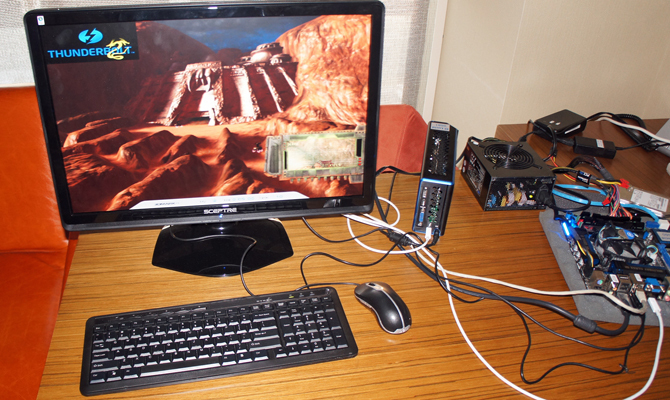Thunderbolt Graphics Technology Turns Your Ultrabook Into a Gaming Rig

Your Ultrabook's onboard graphics chip may be good enough for some gaming, but what if you could enjoy all the power of a high-end desktop video card or even dual video cards, every time you sat down at your desk? A new technology from Lucid, makers of the Virtu MVP graphics acceleration software, will let you attach any Thunderbolt-enabled notebook to an external graphics card that's good enough to transform your 3-pound ultraportable into a heavy-hitting gaming system.
In a private briefing on the eve of Intel's Developers Forum, Lucid allowed us to go hands-on with a prototype Thunderbolt graphics card. To show the difference in performance discrete graphics makes, Lucid first had us run the 3DMark06 benchmark on a standard Ivy Bridge motherboard using Intel's integrated Intel HD Graphics 4000 chip, where the system returned a mediocre rate of 28 frames-per-second.
We then closed out of 3DMark06 and plugged the external graphics card, which had its own case and power supply, into the computer's Thunderbolt port. The screen went black for just a second or two and then the external video card, which in this case was an AMD Radeon 6700 chip, appeared in the Windows Device Manager under Display adapters. We launched 3DMark06 again and this time saw a frame rate of around 89 fps.
What happens when you accidentally (or purposefully) disconnect the external graphics card from your laptop while you have a program running? Lucid's Thunderbolt graphics software will simply force close your application and return you to the Windows desktop, without forcing you to reboot or allowing a system crash. While this solution isn't ideal, it is far superior to the epic Blue Screen of Death you'd experience if you yanked a video card out of your motherboard with the system running.
The notebook world has long been waiting for truly powerful and practical external graphics solution. Back in 2007-2008, ASUS teased mobile gamers with its XG Station graphics peripheral, which when it finally appeared, was only available in a few distant markets like Australia. Since then, a handful of notebooks like the Gigabyte M2432 have had proprietary graphics docks that gave them a little more oomph, but nothing to type home about. A number of companies also sell USB docks that employ DisplayLink technology that allows you to output to several monitors at once, but the performance of these isn't good enough for serious gaming.
When it comes to market, Lucid's Thunderbolt video solution could change the way we look at notebook gaming. Today, if you want a portable gaming rig that really performs, you plunk down several thousand dollars on a gaming system that's probably too bulky to carry. Tomorrow, you could have the best of both worlds: a light-weight Ultrabook that can play mid-range titles like World of Warcraft on the road, and demanding games like Batman: Arkham City when you come home and attach it to an external video card.
Even better, with graphics over Thunderbolt, users will be able to upgrade to their notebooks' video capabilities without purchasing a new system or whipping out a screwdriver. If your current external video card is getting long in the tooth, simply toss it and buy a better one. Lucid even told us that the technology could be used to support dual-graphics cards in SLI or possibly to daisy chain multiple cards together for maximum performance.
Stay in the know with Laptop Mag
Get our in-depth reviews, helpful tips, great deals, and the biggest news stories delivered to your inbox.
Right now, however, Lucid's external Thunderbolt graphics technology is still under development with no set release date and no official partners on board. However, today's notebook buyers can take heart as the company says that graphics peripherals based on its technology should be compatible with current-generation Ultrabooks that have Thunderbolt on board.

